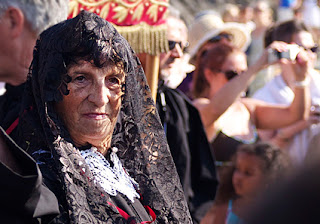 |
| Listening to mass |
The
Fêtes de St Vincent enters day three with mass at the tiny Chapelle
Saint-Vincent.
It
stands atop what was once a minute, rocky island, but it was joined to the rest
of the land many years ago, and now watches quietly over the sun worshippers on
the two beaches on either side of the spit of land that links it to Collioure's
iconic Notre Dame des Agnes.
There
was not a huge crowd attending, but still far too many to crowd into the
chapel, so they stood outside and listened.
 |
| Barques at the beach |
But
the main event is less the service itself and more the procession sur mer that follows it.
The
little chapel empties as members of a confraternity appear, some bare-footed.
Led by an elderly man in a red robe with a bell, a man with a cross and a young
boy in black carrying a banner, they make their way down the steep steps onto
the beach, carrying a reliquary with (apparently) a piece of St Vincent’s bones
in it.
All
glistening gold, with red flowers sticky-taped to each corner, it’s transported
then beneath a canopy to the shore, there to meet and board one of the waiting
barques (traditional
Catalan fishing boats) that are decked out with the red
and yellow striped Catalan flag.
 |
| Making sure it's all ship shape |
It's
no mean feat to get the reliquary up a gangplank and safely onto the boat –
this year, even mayor Michel Moly had to lend a hand, although the senior
clerics didn’t, of course.
The
mayor was then joined on board by at least three clergy, plus male members of
the confraternity.
The
men have been followed by a number of women, dressed in traditional, lacy
Catholic black, which manages to look a tad Mafia-like when accompanied by
designer sunglasses.
The
boats push off, back into deeper water, and process around the bay in convoy.
It seems probable that each beach gets a blessing.
Last
year, when we witnessed this for the first time, they headed straight for
Boramar – in effect, around the corner and pretty much
This
time, the little flotilla made its way across the bay to Port d'Avall,
following the arc of the land around, before heading finally to land at
Boramar. Perhaps the sea was less frisky than last year?
As
they drew toward the shore, a young couple played traditional Catalan
instruments in welcome.
At
the water’s edge, the boats are greeted by swimsuited holidaymakers and elderly
locals in traditional dress – the latter are there as a choir to ensure that
the subsequent hymn sounds decent.
Then,
after a couple of prayers led by the senior cleric present – and as slight
aside, you can tell the Lord’s Prayer just by the rhythm, regardless of the
language – they take up their positions in the procession again and make their
way to Notre Dame des Agnes, where a final service awaits.
There
was a rather funny moment as the reliquary-carrying group passed me, camera at
the ready, and one suddenly said, out loud and in obvious surprise: “Manchester
City!” Hey, I’ve become known here for wearing footy shirts.
Although
I’m not entirely convinced that football was really what should have been on
his mind at that moment.
So,
that is, in effect, the religious content of the festival.
I
don’t believe any of it for a moment, but there’s something rather delightful
about seeing it.
 |
| The mayor lends a hand |
In
his book The Sign of the Cross: Travels in Catholic Europe, Colm Toíbín talks about
visiting Seville for one of the major festivals, and being fascinated to
discover that some of the men willingly carrying the statues of the Virgin and
assorted saints were communists and atheists.
When
he asked why they did it, their answer was simple: it was tradition.
I
can enjoy carols at Christmas – I don’t need to believe all the various bits
and pieces that were cribbed from assorted cults and other religions.
And
I can appreciate this too, in the same way: it’s traditional and of its place
and its culture. And for a good little Protestant girl like me, there is most
certainly a touch of the exotic.
Nor
is it discomforting in the same way that the sanche is. That ‘march of the
penitents’, which takes place on Good Friday in many parts of the region (we’ve
seen it in nearby Perpignan) includes very small children – something that I do
not like at all.
But
this leaves one with the hope that just enough people continue to join the
confraternities to allow
them to maintain such colourful traditions.
Anyway,
enough of that: here I’ve included a selection of the morning’s photographs.
Not easy, since the light is in the ‘wrong’ place for much of it but c’est la vie,
as the French themselves might put it.
There are advantages to photographing something with which
you’re at least vaguely familiar, and I am particularly pleased with the shots
of the two elderly female members of the confraternity.
There's also a candid that was taken on the beach
at Boramar, of another elderly lady talking with a man. I've included her here because I think she provides a nice contrast to the others. |
| Minstrels |








No comments:
Post a Comment